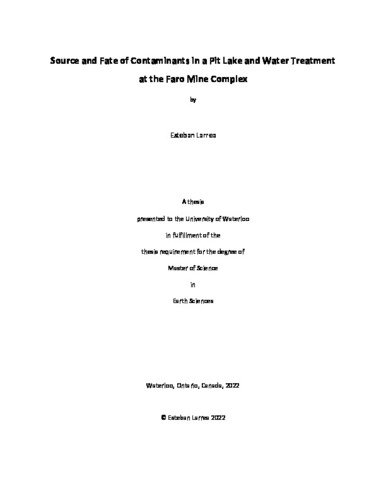| dc.description.abstract | The Faro Mine Complex (FMC) is an abandoned zinc-lead mine in Yukon, Canada that requires extensive remediation efforts to manage the environmental liabilities associated with mine wastes stockpiled at the site. Active care and maintenance are necessary to manage surface water and groundwater impacted by acid rock drainage (ARD) and metal leaching (ML). The Faro Pit lake (FPL) is the largest reservoir of water at the FMC, multiple mine impacted water sources are pumped to the pit lake for storage and mixing. The FPL is also the main influent source to the FMC treatment plant. Active pumping from other mine components and continuous degradation of ARD seepage quality flowing into the pit lake alter the concentration and distribution of contaminants at the FMC. Changes to the load balance of the site may therefore affect contaminant removal processes at the FMC treatment plant. This research project aims to combine a mass balance of contaminant loading in water at the FMC with the characterization of metal removal during the treatment of mine waters. The results would characterize the source, distribution, and fate of contaminants within the FPL.
A sampling apparatus was installed into the FPL on two occasions, in September 2019 and September 2021. Profile samples and in situ measurements were obtained to a depth of 47 m in 2019 and 25 m in 2021. In both years, the pit lake was thermally stratified with a well-defined thermocline between 8 m and 10 m depth. The stratification is caused by the difference in specific density of water at 10 ⁰C and 4 ⁰C, in the epilimnion and hypolimnion respectively. Multiple parameters changed sharply at the well-defined thermocline because mixing between the epilimnion and hypolimnion is limited. In 2019, most concentrations of dissolved species were higher in the hypolimnion than in the epilimnion, whereas the concentrations were generally higher in the epilimnion in 2021. The pH was higher in the epilimnion in 2019, and in 2021 it was lower in the epilimnion at pH 3.8. Increasing contaminant loads from the tailings area Intermediate Pond and seepage from the mine waste surrounding the Faro Pit drive geochemical changes in the pit-lake water quality.
Batch experiments were conducted to understand the processes resulting in removal of dissolved metals during treatment of mine-impacted waters. FPL water samples were placed in a stirred cell reactor (SCR) and dosed with calcium hydroxide to a pH of 10. Samples were collected for characterization of kinetic and thermodynamic controls during water treatment. Contaminant removal during lime treatment is controlled by processes that occur consistently over narrow pH ranges. Results of the batch experiments show that most Fe removal occurred at pH 6.5, Zn was removed at pH 9, Mn removal at pH 9.7, and Ni and Cd removal occurred above pH 10. Characterization of the precipitated solids showed that Fe and some Zn coprecipitated in the initial stage of the experiments. Later in the experiment, Zn precipitated separately, likely as amorphous Zn hydroxides, mixed with Mn (hydr)oxides. The solution remained undersaturated in respect to gypsum and minimal removal of SO4 from solution was observed.
The results from all components of this study suggest that changing geochemical conditions and additional load sources have the potential to change the contaminant distribution and effectiveness of treatment process. This study increased the understanding of the necessary actions to efficiently remove contaminants from a mine with deteriorating water quality and changing operating conditions. | en |

